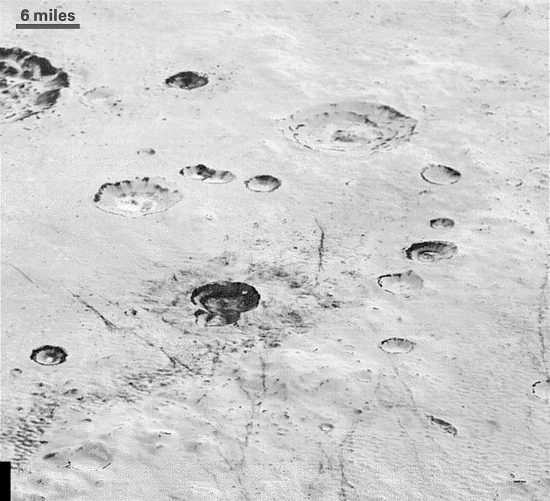
250-kilometer-wide Burney Basin, named after Venetia Burney, the English schoolgirl who first proposed the name “Pluto”. Credit: NASA/Johns Hopkins University Applied Physics Laboratory/Southwest Research Institute
Mar 23, 2017
Pluto’s frigid environment continues to surprise investigators.
Clyde W. Tombaugh discovered Pluto on February 18, 1930. Percival Lowell thought there ought to be another celestial body beyond Neptune because something affected their orbital calculations. A gravitational source was seen to “pull” on both Uranus and Neptune. Since Urbain Le Verrier predicted the existence of Neptune due to similar orbital inconsistencies, Lowell was correct in assuming that “Planet X” was there, although he never found it. After Tombaugh’s discovery, a write-in contest resulted in an 11-year-old girl named Venetia Burney suggesting that Planet X be called “Pluto” after the Roman god of the dead.
Pluto is in a highly eccentric orbit. Aphelion is 7.3 billion kilometers from the Sun, while perihelion brings it no closer than 4.4 billion kilometers. One revolution takes about 248 years, longer than the existence of telescopes that can see it. The last time Pluto was in the same place in its orbit as it is now was ten years before the American war for independence in 1776.
Several moons are in orbit around Pluto. Charon, at 1172 kilometers, is the largest followed by Styx, Kerberos, Hydra, and Nix. Pluto and Charon orbit a common barycenter, so the other four moons are circling the pair. There could be other moons too dim to see, so New Horizons could increase that number. As of the last count, 181 moons orbit the planets, 97 moons orbit bodies in the asteroid belt, 79 moons orbit Trans-Neptunian Objects, etc.
On July 14, 2015 New Horizons flew by the dwarf planet at a distance of 9656 kilometers. The RALPH instrument (named after Alice’s husband in the television show The Honeymooners) was able to resolve features on Pluto that are about a city block in size. As the image at the top of the page indicates, Pluto resembles other rocky bodies much closer to the Sun. Gas giant moons experience similar temperatures, and could also have been exposed to the same kind of formative processes that created Pluto.
The geology of Pluto is intriguing because of “mysteries” and “processes that have yet to be understood.” Complex chains of craters and melted pits extend outward from terraced depressions. Flat bottoms and vertical sidewalls are signs of electric discharge machining. Indeed, the indications are that electrically active phenomena sculpted Pluto’s surface.
As previously written, Pluto resembles its sister moons and dwarf planets. There are areas where ripples and “cantaloupe” terrain dominate. There are steep-walled craters with flat floors, hexagons, thousand-kilometer trenches, hectares of pits, craters on the rims of other craters, and other features that mark Pluto as an electrically devastated world. However, that devastation took place sometime in the past, leaving Pluto a blasted, frozen hulk.
There is little electrical connection between Pluto and the Sun because Pluto has no magnetosphere, so no shield between it and solar wind ions. Similar to other rocky planet-sized bodies, it sports a long tail composed of heavier, ionized atmospheric gases―primarily methane, with a “thin” magnetopause. The so-called “Plutopause” is the boundary region between solar plasma and Pluto’s feeble electromagnetic field, so its equipotential surface is small.
More data continues to be analyzed. As time goes on, Electric Universe advocates expect Pluto to exhibit attributes that mark its electrical birth and morphology.
Stephen Smith












